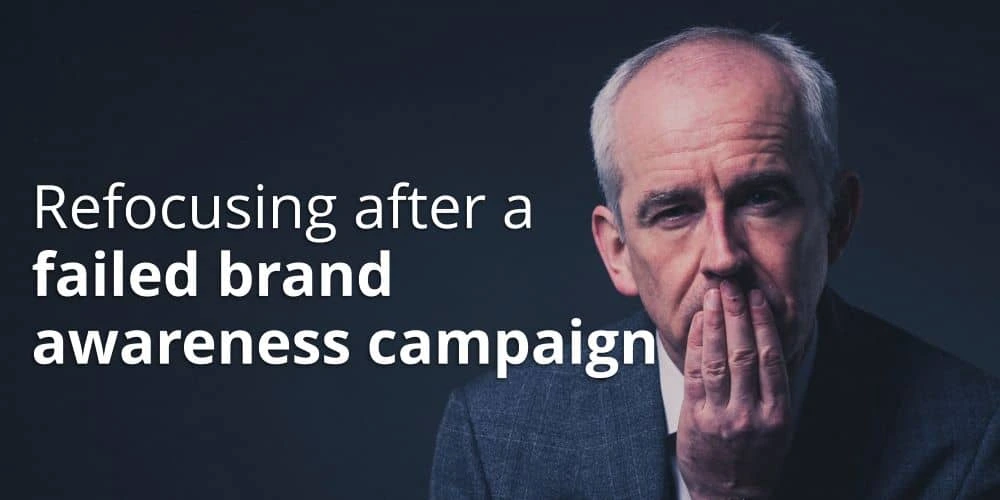Newcomers to the world of brand awareness marketing often feel overwhelmed or utterly lost. There’s a veritable plethora of channels, tactics & tools to explore. To make things even more difficult, some make much more sense for your business than others, depending on a matrix of circumstances.
Related: 7 things to consider before your next social media campaign
Before jumping into a brand awareness campaign, remember to ask yourself these key questions.
Is your content tailored to the right people?
You’re pretty sure you wrote compelling content… but is that actually the case? It’s time for a bit of self-reflection and honesty, which—while sometimes tough to swallow—is vital to the refocusing process.
One of the easiest mistakes to make in brand awareness campaigns is tailoring the content towards current customers. In reality, you’re targeting potential customers instead. [![]() ]
]
The people you’re targeting likely have no idea who you are prior to seeing your ad. This is why the content has to be super compelling, either to draw them into visiting your site right away or ensuring that when they need a service or product like yours, you’re at the front of their mind.
The main things you need to include within the copy are:
- The unique selling points of your business—what makes you different from all of your competitors?
- How you can solve their problems—most consumers have some sort of problem (which is why they purchase services/products), so tell them how you can be the answer they’re looking for.
- A convincing call to action—whether this is telling them to visit your site, sign up for your newsletter or take advantage of a limited-time promotion or discount, tell people why they should act on their impulses now.
Put yourself in the shoes of your potential customers. What would you want to read? What would convince you to use your own product or service?
Marketers often forget to place themselves in the shoes of their target market and instead take a product-oriented approach.
Are you targeting the correct people?
Next, examine your target audience. Are you completely confident that you targeted the correct people? If your brand awareness campaign failed, then it’s possible you performed for the wrong audience.
Basing your target audience on your current customers seems like the place to start. They clearly love your brand, so people who share the same interests are your perfect target, right? Not necessarily.
In most cases, the audience you want to target is going to be slightly different. Before your current customer base found you, they were high-intent users actively searching for an answer to their problems.
In a brand awareness campaign, however, your audience isn’t likely to be high-intent when they first see your ads.
This is where you have to be creative; think about the types of people who may have pain points you can solve but don’t quite know it yet.
Think about the age range that’s most likely to face these pain points soon. Are there any geographical areas more likely to need your help? Are there any interests people have that could likely lead to needing you?
For example, if your brand specializes in decorating services, based on intent and life event options, you can target people who are moving soon or have recently moved. This would be more effective than simply targeting people who love decorating.
Are you tracking success correctly?
Finally, let’s review how you measure your brand awareness campaign’s success. You could run a hugely beneficial campaign, but if you’re focused on the wrong metrics, you may see it as a failure and not capitalize on it.
There are so many metrics you can use to gauge the success of a campaign that it can be difficult to know exactly what you should be looking for.
Success metrics should be chosen during the planning stage of your campaign, to give you a clear view of how the campaign should be structured and how you can get a sensible idea of the performance.
When you sit down to decide these metrics, use SMART goals and objectives. Many of you have probably already heard this acronym, but just in case, it stands for specific, measurable, attainable, realistic and timely.
Setting your goals this way will help you get an in-depth understanding of which metrics to evaluate when measuring the campaign’s success.
And when it comes to brand awareness campaigns, success can be harder to measure. Focus on top-of-funnel metrics rather than sales or conversions. When it’s over, don’t stop reporting just because the initial boost of traffic and engagement has died down. Remember that these campaigns can continue to pay off with gradual increases over time.
Common brand awareness mistakes
With so much on the line, you can’t afford to dive in unprepared. Here are 7 rookie mistakes that often fly under the radar yet profoundly impact your brand awareness strategies and goals.
Mistake #1: Scattergun approach
Spreading yourself too thin is an easy trap to fall into. You can’t please and cater to everyone—and you shouldn’t. In fact, attempting this futile endeavor will result in satisfying no one.
Case in point: many startups establish accounts on every social network they can, only to find that managing them all is virtually impossible. Even if you do post to every network with the help of automation, you’re not delivering a great experience tailored to that platform—and you’re likely missing out on a lot of engagement.
Instead, do your research to find a highly targeted market. Know who they are and understand their habits, wants & needs. You have to find where they are and spend time there, not in a hundred places where you desperately hope to stumble upon them.
Mistake #2: Passive social presence
A “build it and they will come” mentality does not work on today’s internet. You can’t just set up a website or social media page and hope to see customers eagerly interacting with your brand. First, you have to engage the audience. Responding to comments in a timely manner is a good place to start… but it’s only a start.
Come up with a content calendar and post on a regular basis. Talk to users and influencers, and ask them for opinions. Use your social presence to carry out customer service around the clock via instant messaging and other channels. Social media is about building lasting, meaningful connections that strengthen brand loyalty. You can’t simply stuff your messages with hashtags and expect magic to happen.
Mistake #3: Incoherent cross-channel strategy
Rookie marketers tend to lose sight of the big picture and how coherent their messages appear across different channels. This is not the way to build strong credibility and inspire trust. Successful brand marketing is deeply rooted in consistency.
This journey calls for much more than investing in a decent logo and slapping it everywhere you can. You will need to use elements like the color palette, fonts, visual identity, images, and voice to set the tone for your marketing campaigns. Tailor to the medium and the platform, of course—but never lose the integral pieces of your brand’s identity. [ ]
Mistake #4: Overcommitting to digital
Cost-effective digital platforms have unparalleled reach, but they are not be-all and end-all of brand marketing. Not everyone is tuned in to social media, apps and online search. Depending on your target market, you could work wonders with print collateral or merchandising.
In other words, you can let human psychology work to your advantage and leave a lasting impression by giving away branded office supplies, quality printed shirts, and other handouts. Don’t overlook the potential of printed media. You could reach a lot of people via brochures, business cards, flyers, newsletters, and other printed marketing materials. In the digital era, print is personal and memorable.
Mistake #5: Going all-in on advertising
Advertising is the mainstay of many brand awareness campaigns. However, it’s generally a bad idea to put all your eggs in one basket-especially if you’re a rookie who’s worried about wasting your budget.
What’s more, people have grown weary of aggressive pop-ups & ads, even when they’re targeted with laser-like precision. They install ad-blockers to completely shut them down.
Instead, try to start small and set aside a limited ad budget. Test your awareness campaigns over a course of few weeks and evaluate the results. Paid marketing works best when you prioritize ROI, so as you learn the ropes, gather data and scale your campaigns based on your insights.
Mistake #6: Misunderstanding content marketing
Viral marketing is one way to enter with a big bang, but directing all your efforts there is a double-edged sword. If you win, you win big. If you don’t, you get nothing. You’re probably better off crafting compelling, quality content on a consistent basis. Be entertaining, educational, and add value to people’s lives.
Once you start producing a stream of relevant content, you have to promote it. Bear in mind that you might not achieve immediate success. Don’t cut corners, and show patience. It takes time to gain momentum and traction. In due time, your efforts will start to snowball via word-of-mouth and social signals.
Mistake #7: Disregarding or copying the competition
It always pays off to scope out the competition. Doing this homework will show you what works for them—and what doesn’t. You gain valuable insights that help you set your brand apart. You should always keep an eye on what others are doing, but refrain from imitating them.
Looking and feeling like another business stirs brand confusion and slows the development of your own reputation. Instead, being genuine is the best way to win people over and keep them in your camp. That being said, you can still borrow good ideas and implement them in your marketing strategy. Just make sure you’re doing it in a way that’s fresh and authentic to your brand.
Key takeaway: Brand awareness by design
Effective brand awareness campaigns are hard to pull off. You have to put the right messages in the right place and serve it to the right people. Much easier said than done. There’s a lot of ground to cover without losing your footing and plenty of tools to consider.
Right away, put a sound strategy in place and let it guide your efforts across channels and platforms. Steer away from common mistakes that can bite off a big chunk of your budget and hinder your brand. Concentrate on turning curious visitors into prospects, prospects into customers, and customers into satisfied brand ambassadors.



